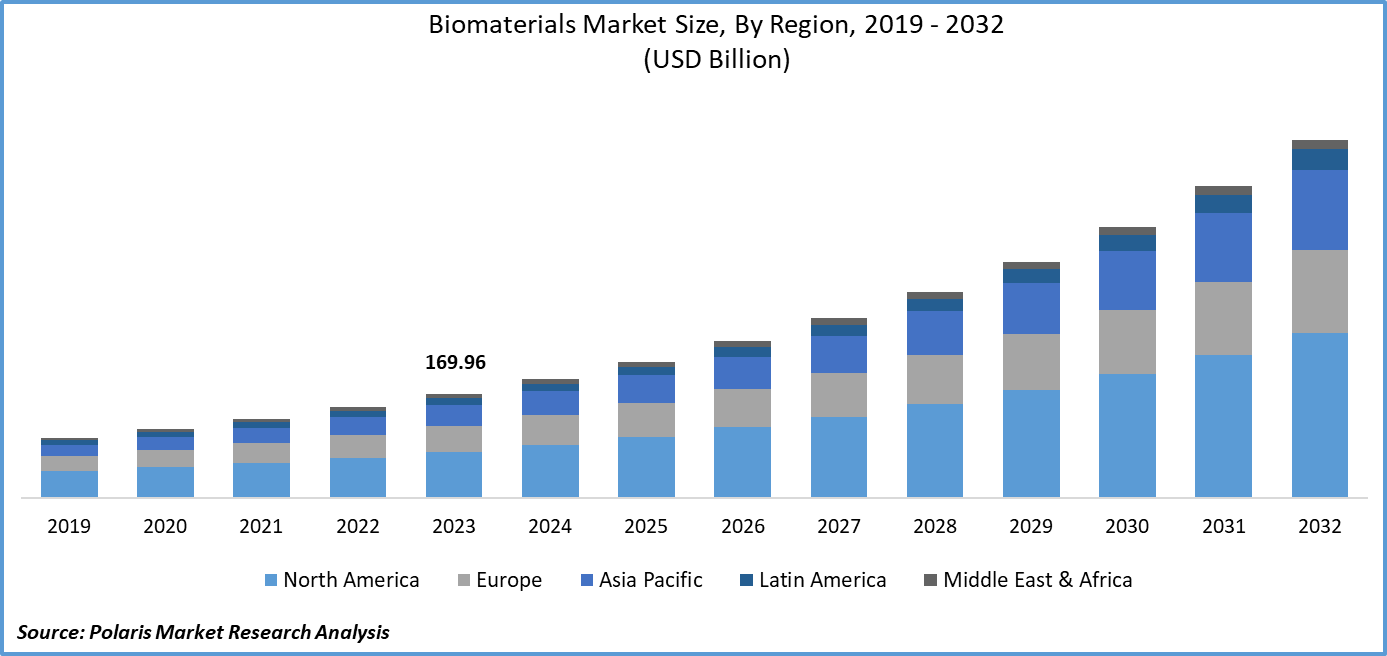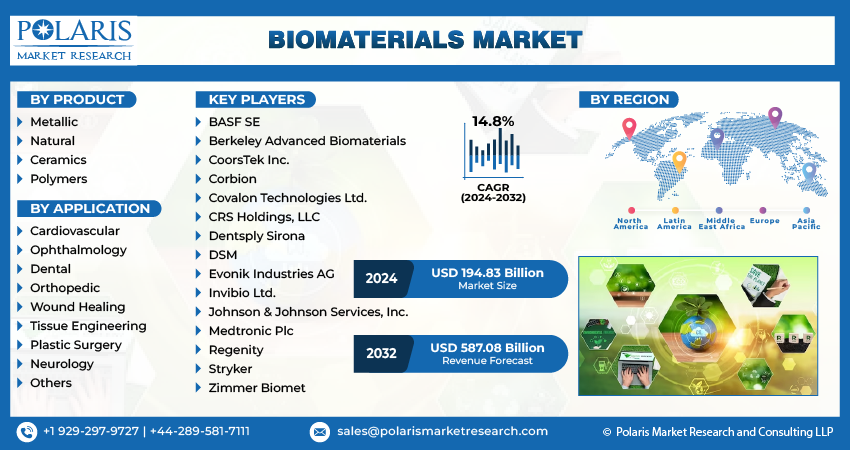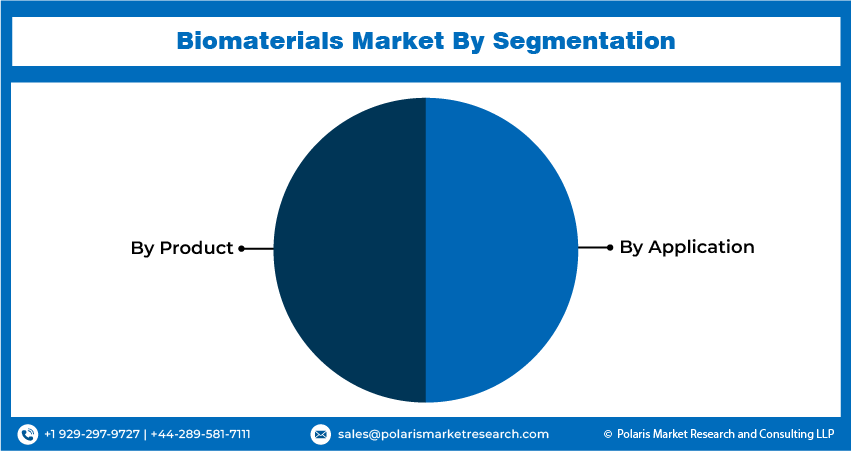
Biomaterials Market Share, Size, Trends, Industry Analysis Report
By Product (Metallic, Natural, Ceramics, Polymers); By Application; By Region; Segment Forecast, 2024 - 2032
- Published Date:Mar-2024
- Pages: 116
- Format: PDF
- Report ID: PM4756
- Base Year: 2023
- Historical Data: 2019 – 2022
Report Outlook
Global biomaterials market size was valued at USD 169.96 billion in 2023. The market is anticipated to grow from USD 194.83 billion in 2024 to USD 587.08 billion by 2032, exhibiting a CAGR of 14.8% during the forecast period
Industry Trends
Biomaterials are materials that are used in contact with living tissues and have the potential to interact with cells, tissues, or organs, either by being integrated into the body or by being used as surfaces for medical devices. The development of new biomaterials has revolutionized medicine and healthcare, enabling the creation of novel treatments and therapies for a wide range of diseases and conditions.
The global biomaterials market is a rapidly growing industry that is driven by the rising prevalence of chronic diseases, the increasing need for minimally invasive surgeries, and an aging population. In addition, technological advancements in biomaterials have led to the development of new products and applications, such as bioabsorbable materials, nanotechnology-based biomaterials, and tissue engineering scaffolds.

To Understand More About this Research: Request a Free Sample Report
For instance, in January 2024, Consumer Electronics Show in Las Vegas, Nevada, Xenco Medical unveiled its TrabeculeX Continuum technology. This technology serves as a bridge between orthobiologics and digital health, providing a unified approach to a patient's biomaterial implantation and postoperative journey.
One of the key market trends in biomaterials is the shift towards sustainability since there is a growing need for biodegradable and biocompatible materials that can reduce the environmental impact of medical devices and minimize the risk of adverse reactions. This has led to increased research and development in natural polymers, such as chitosan, alginate, and hyaluronic acid, which are derived from renewable sources and offer excellent biocompatibility and biodegradability properties.
Another major industry trend in the biomaterials market is the integration of technology with biomaterials. Advances in fields like nanotechnology, 3D printing, and sensors have enabled the creation of novel biomaterials with enhanced functionality and performance. Despite these growth drivers, the biomaterials market is hindered by the high cost associated with the production and processing of advanced biomaterials. In addition, stringent regulatory requirements and lengthy approval times pose significant barriers to entry for new players in the market. Overall, the market outlook for biomaterials remains positive due to its critical role in improving healthcare outcomes and addressing unmet clinical needs.

Key Takeaways
- North America dominated the market and contributed over 36% market share of the biomaterials market size in 2023
- By product category, the polymer segment dominated the global biomaterials market size in 2023
- By application category, the plastic surgery segment is projected to grow with a significant CAGR over the biomaterials market forecast period
What are the Market Drivers Driving the Demand for the Market?
Increasing Demand for Medical Devices and Implants Drives Biomaterials Market Growth
The increasing demand for medical devices and implants is significantly driving the growth of the biomaterials market. As the population ages and the prevalence of chronic diseases continues to rise, there is a growing need for advanced medical technologies that can improve patient outcomes and quality of life.
Biomaterials play a crucial role in the development of these technologies, as they are used to create medical devices and implants that are compatible with the human body and can perform effectively over long periods. From implantable devices such as pacemakers and artificial joints to surgical meshes and dental implants, biomaterials are essential components in modern medicine. The rising demand for these devices has led to increased research and development in the field of biomaterials science, resulting in new and innovative materials being developed that offer improved properties and performance. This, in turn, has fueled further advancements in medical technology, creating a positive feedback loop that drives the growth of the biomaterials market.
Which Factor is Restraining the Demand for Biomaterials?
High Costs and Regulatory Hurdles are Hindering the Biomaterials Market Growth
The development and production of biomaterials are usually expensive due to the high cost of raw materials, complex manufacturing processes, and strict quality control requirements. Also, regulations governing the use of biomaterials in various applications, such as medical devices, pharmaceuticals, and tissue engineering, are stringent and time-consuming, increasing the overhead costs for companies operating in this space. In addition, the need for standardization in the industry makes it difficult to ensure consistent quality and performance of biomaterials, further increasing the costs and risks associated with their use. These factors collectively create barriers to entry for new players and limit the widespread adoption of biomaterials, thereby hindering the market's growth potential.
Report Segmentation
The market is primarily segmented based on product, application, and region.
|
By Product |
By Application |
By Region |
|
|
|
To Understand the Scope of this Report: Speak to Analyst
Category Wise Insights
By Product Insights
Based on product category analysis, the market has been segmented into metallic, natural, ceramics, and polymers. The polymer segment dominated the global biomaterials market in 2023 due to its versatility, biocompatibility, and wide range of applications. Polymers are widely used in various medical devices, such as implants, drug delivery systems, and tissue engineering scaffolds, owing to their ability to be tailored with specific properties such as degradability, mechanical strength, and bioadhesion.
Also, advancements in polymer technology have led to the development of novel polymers with improved performance and functionality, further increasing their appeal in biomedical applications. For instance, in March 2023, Invibio Biomaterial Solutions introduced Peek-Optima Am filament, a high-performance implantable polyetheretherketone (PEEK) polymer that is designed specifically for the production of 3D-printed medical devices. Overall, the polymer segment's diverse portfolio of materials and their adaptability to different biomedical needs make them an attractive choice for researchers and manufacturers, contributing to their dominant share in the biomaterials market.
By Application Insights
Based on application category analysis, the market has been segmented on the basis of cardiovascular, ophthalmology, dental, orthopedic, wound healing, tissue engineering, plastic surgery, neurology, and others. The plastic surgery segment is expected to grow significantly in the forthcoming years, driven by the increasing demand for biomaterials used in reconstructive and cosmetic procedures. Biomaterials play a crucial role in plastic surgery, as they are used to create implants, prosthetics, and other medical devices that are compatible with the human body. The growing demand for biomaterials in plastic surgery is attributed to advancements in technology and an aging population seeking cosmetic procedures. Also, the development of innovative biomaterials such as nanomaterials, biosensors, and tissue engineering scaffolds has expanded the scope of plastic surgery, enabling surgeons to perform complex procedures with greater precision and accuracy. All these factors are contributing to the growth of the plastic surgery segment in the biomaterials market.

Regional Insights
North America
The North American region emerged as the dominant region in the global biomaterials market in 2023 due to the presence of a well-established healthcare industry and advanced medical infrastructure in countries such as the United States. This has led to a high demand for biomaterials in the region, particularly in applications such as implants, surgical meshes, and wound care products. Also, the region has a strong research and development sector, with numerous universities, research institutions, and companies investing heavily in biomaterials research and development. This has resulted in the development of innovative biomaterial technologies, which have contributed to the growth of the market.
Asia Pacific
The Asia Pacific region is anticipated to grow substantially in the global biomaterials market over the forecast period due to the increasing demand for healthcare services and medical devices in countries such as China, India, and Japan. As the population in these countries ages, there is a growing need for advanced healthcare solutions, including biomaterial-based medical devices, which can improve patient outcomes and quality of life. Also, governments in the region are investing heavily in research and development (R&D) initiatives to promote innovation and drive economic growth, which has led to an increase in R&D activities related to biomaterials.

Competitive Landscape
A diverse range of players, including established multinational corporations, emerging startups, and research institutions, characterizes the competitive landscape for the global biomaterials market. Some of the key players in the market include BASF SE, Evonik Industries AG, Royal DSM NV, and Stryker Corporation, among others. These companies have a strong focus on research and development. They are constantly developing new and innovative biomaterial products to meet the evolving needs of various industries, such as healthcare, cosmetics, and agriculture. In addition, numerous startup companies are focused on developing novel biomaterials technologies, such as biodegradable plastics, nanomaterials, and bioactive coatings.
Some of the major players operating in the global market include:
- BASF SE
- Berkeley Advanced Biomaterials
- CoorsTek Inc.
- Corbion
- Covalon Technologies Ltd.
- CRS Holdings, LLC
- Dentsply Sirona
- DSM
- Evonik Industries AG
- Invibio Ltd.
- Johnson & Johnson Services, Inc.
- Medtronic Plc
- Regenity
- Stryker
- Zimmer Biomet
Recent Developments
- In September 2023, Stryker introduced Citrefix, an advanced suture anchor system for foot and ankle surgery. The innovative system utilizes a citrate-based biomaterial known as Citregen, which is a bioresorbable substance engineered to replicate the chemistry and structure of natural bone tissue.
- In September 2020, Evonik introduced a new PEEK (polyether ether ketone) product named VESTAKEEP Fusion, which exhibits enhanced osteoconductive properties for the medical industry. This innovative material is designed to enhance bone-implant fusion and improve the overall success rate of medical implants.
- In August 2021, botiss introduced the latest version of its dental biomaterials, the NOVAMag product line. This innovation provides a durable yet fully biodegradable option for dentists who require a biomaterial that maintains its mechanical strength.
Report Coverage
The Biomaterials market report emphasizes key regions across the globe to help users better understand the product. It also provides market insights into recent developments and trends and analyzes the technologies that are gaining traction around the globe. Furthermore, the report covers an in-depth qualitative analysis of various paradigm shifts associated with the transformation of these solutions.
The report provides a detailed analysis of the market while focusing on various key aspects such as competitive analysis, product, application, and futuristic growth opportunities.
Biomaterials Market Report Scope
|
Report Attributes |
Details |
|
Market size value in 2024 |
USD 194.83 billion |
|
Revenue Forecast in 2032 |
USD 587.08 billion |
|
CAGR |
14.8% from 2024 – 2032 |
|
Base year |
2023 |
|
Historical data |
2019 – 2022 |
|
Forecast period |
2024 – 2032 |
|
Quantitative units |
Revenue in USD billion and CAGR from 2024 to 2032 |
|
Segments Covered |
By Product, By Application, By Region |
|
Regional scope |
North America, Europe, Asia Pacific, Latin America, Middle East & Africa |
|
Customization |
Report customization as per your requirements with respect to countries, regions, and segmentation. |
FAQ's
The Biomaterials Market report covering key segments are product, application, and region.
Biomaterials Market Size Worth USD 587.08 Billion by 2032
Biomaterials Market exhibiting a CAGR of 14.8% during the forecast period
North American is leading the global market
key driving factors in Biomaterials Market are BASF SE, Berkeley Advanced Biomaterials, CoorsTek Inc., Corbion, Covalon Technologies Ltd., CRS Holdings
